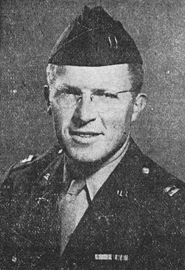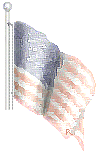Story of the Rainbow Division Being Re-Enacted in Present War
“Coming down out of the cold, wet mountains of Italy, were we had spent much of the winter, we could see Cassino and its fortifications two or three miles away on the opposite side of the Rapido river. We spent about a week studying the terrain and made six attacks within four days before we succeeded in making a crossing. The Germans had measured the valley to the last inch and registered their artillery, mortars, and machineguns on the route we had to follow.”
That is the way Capt. John E. Agnes, 108 12th street, begins his story of the last battle in which he participated with former Sioux City national guard units before returning to this county.
12 Years in Guard
Capt. Agnes is a real national guard veteran. He enlisted as a private 12 years ago and had attained the rank of second lieutenant by the time the units were mustered into federal service and sent overseas as part of the 34th Division.
“In peacetime, we had to listen to lots of disparaging remarks,” he says, “But I think the 34th has proved that national guardsmen are among the country’s best fighting organizations. We fought all the way through the Tunisian campaign and did a lot in the invasion of Italy. The attack on Cassino was just one of many battles in which Sioux City boys distinguished themselves.”
In addition to registering their guns on the valley, the Germans also had sewn many antipersonnel mines across the path of the invading forces and had dammed the river and diverted its course to form tank traps. Barbed wire was strung all along the river bank.
Finally Cross River
“The entire valley was covered by German fire,” Capt. Agnes says. “Each attack we made took just a little more courage and determination. Finally, on the sixth attack, with the help of tanks, we managed to cross the river. Our crossing was made about one-half mile north of Cassino, and we still had a bunch of Italian barracks and numerous pillboxes to clean out before we reached the town.”
“The march into Cassino was a remarkable example of coordination between infantry and tanks,” he continues. “Two tanks took the lead and sprayed the hillsides with machinegun fire. The infantry rolled almost behind, digging out pillboxes and pointing out their location to a following wave of four tanks. The pillboxes were demolished one by one with .75-millimeter shells fired from tanks.”
On the third day after crossing the river, American forces entered the outskirts of Cassino. The momentum of the attack carried them through until they controlled approximately one-third of the city. After holding their positions for two weeks, the American forces were relieved by New Zealand troops and retired to a rest area in the mountains.”
Expects New Assignment
While other members of his unit were in the rest area, Capt. Agnes was detached from duty and sent home. He expects to receive a new assignment by mail before the end of his 21-day furlough.
“As everyone knows, our Sioux,” he says. “We were widely scattered in many small Irish villages, and lost track of each other. We crossed Scotland and spent 10 days in England before we were first two months of the African weeks of guard duty in Oran, we started the long trip into Tunisia.”
Crossing the mountains in north Africa, the Sioux City units ran into a blizzard February 10, 1943. They traveled a considerable distance through howling winds and driving snow, which piled up 8 to 10 inches deep.”
“Our first contact with the enemy came February 17th,” the Captain says. “I think we were all scared to death—I know I was. But our morale went up rapidly. We were on high ground and had a clear view of the entire action. Our antitank guns destroyed four German tanks and cleared the path for our advance.”
British Rations
The next engagement was the defense of Kef Elanar pass, where the Americans lost many prisoners, but prevented the Germans from breaking through. During the first two months of the African campaign, American soldiers lived largely on Britsh rations, consisting of kidney bean stew and tea.
At Veja, however, the Americans received new equipment and American food, and the big offensive began down the Side Nisia valley, over and around the famous Hill 609, to Eddi Kihita.
“That, I think, was the best planned and executed battle I saw,” Capt. Agnes says. “We spent the entire night making plans. When we opened up in the morning, the German defenders ran for their lives. The drive ended May 8, and we woke up the following morning to find that there were no enemy troops within miles of us.”
Guarded Prisoners
During the remainder of May and the entire month of June, Capt. Agnes and his men sorted and salvaged abandoned German and Italian equipment and furnished guard groups for approximately 250,000 prisoners of war. They also helped process and equip other forces for the invasion of Sicily.
“We missed Sicily,” he says, “but we were close behind the first attacking force on the Italian mainland. The battle was going on about seven miles inland and within plain sight of our forces as we landed south of Salerno. We found many Italians who claimed to have valuable information regarding German strength and installations. They wanted to assist us in our advance, but we were skeptical and turned them over to intelligence officers for questioning.”
The former national guard units were in action against the Germans again from the middle of September to November 1, with the Germans fighting a delaying action to hold up the American advance.
Rain and Cold
Following the five crossings of the Volturno river, the advancing army moved into the Italian mountains early in November. The rain and cold caused a great deal of suffering, Capt. Agnes says. French colonial troops relieved the Americans December 10, and they were in a rest area until December 31, when they again went into the front lines.
“We were above timber line in the mountains and the temperature was below zero most of the time,” Capt. Agnes says. “Most of the time the snow as more than a foot deep. We spent the entire month of January in those mountains and came out January 28, for our first look at Cassino and the wide open valley which barred our way.”
Source: The Sioux City Journal, April 9, 1944
![]()
IN UNIFORM
John E. Agnes, son of Mr. and Mrs. E M. Agnes, 108 12th Street, has been promoted from captain to major, according to an announcement Saturday from the war department. Maj. Agnes is stationed at Fort McClellan, Alabama. Joining the National Guard more than 10 years ago, he served overseas in Africa and Italy. For heroic action in the 1943 Tunisian campaign, Maj. Agnes was cited for meritorious conduct in the vicinity of Tunis. He also was praised for bravery by brother infantry officers for his actions on the rocky slope on Hill 1190 at Visichitara, Italy. At the time the earlier citation was awarded, he was commanding officer of a 37-mm, platoon.
Source: The Sioux City Journal, August 20, 1944 (photo included)
![]()
MAJ. JOHN E. AGNES IS AWARDED STAR
The Silver Star has been awarded to Maj. John E. Agnes, 31, infantry, a son of Mr. and Mrs. E. N. Agnes, 108 12th street, for gallantry in action against the Germans, the War Department announced Tuesday. The officer was advanced to a major’s rank early in August.
Source: The Sioux City Journal, September 19, 1944
![]()
IN UNIFORM
Maj. John E. Agnes, son of Mr. and Mrs. E. M. Agnes, 108 12th street, has been awarded the bronze star medal, the War Department has announced. Maj. Agnes, who was promoted to Major in August, is stationed at Fort McClellan, Ala. He joined the national guard more than 10 years ago and served overseas in Africa and Italy. For heroic action in the Tunisian campaign, Maj. Agnes was cited for meritorious conduct. He also was praised for bravery by brother infantry officers for his action in Hill 1190 at Vischitara, Italy.
Source: The Sioux City Journal, November 7, 1944
![]()


